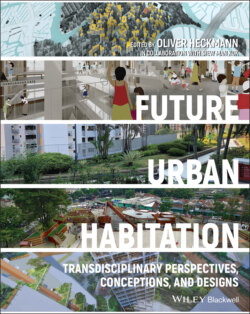Читать книгу Future Urban Habitation - Группа авторов - Страница 20
Agencies of Inclusion
ОглавлениеInstruments to prevent exclusion and to cater for inclusive cities with ‘just spaces’, in which people ‘feel welcome’ (Armborst et al. 2017) are manifold, can be either legislative, financial, or project‐based, bottom‐up or top‐down – and might often emerge across different fields, parties, and strategies. The actors are both spatial and social designers, administrative bodies, legislators, NGOs, or community initiatives. The contexts of intervention are simultaneously legal, spatial, and social and affect both the design and operation of habitats.
One aspect often raised is the control of property prices or their entire withdrawal from unrestrained market mechanisms – an important prerequisite to prevent gentrification and displacement. There is an increasing recognition that profit maximization in an essential good like housing is problematic and that non‐profit economic models are more sustainable in the long term. Examples are the Limited‐Profit‐Housing Act applied in Vienna and Austria in general, to provide habitats whose economic viability is not based on short‐term profit‐maximization but on creating habitats that are sustainable, both socially and ecologically, in the long term (see Gerald Kössl’s chapter). To restrain property speculation, since 2016 public land in Berlin is only awarded as leasehold, (Weißmüller 2018). In Zurich, a referendum decided in 2011 that by 2050 one third of the city's total rental stock should be affordable, non‐profit apartments, so that by now 27% of rental apartments operate on a non‐profit basis, with 20% run by cooperatives (Kalagas 2019). Other models secure affordable apartments ownership by lease‐to‐own financing policies to support social sustainability and stable communities, such as with the Puukuokka Housing project in Finland (Hamm 2015). Here, a small down payment on the purchase price entitles dwellers to a state‐guaranteed loan.
In Singapore, 80% of the permanent population live in subsidized apartments built by the public Housing & Development Board, almost all of them as owner‐occupiers (The Economist 2017), while speculative spikes in property prices are in general limited by taxation policies (Deng et al. 2019). Also, in the Canadian province British Columbia, a Speculation and Vacancy Tax (Government of British Columbia 2020) penalizes property acquisitions purely based on asset building. But while Inclusionary Zoning legislations in New York also claim to prevent segregation, Madden and Marcuse (2016) criticize these policies for leaving the provision of affordable housing entirely to the market and having significant loopholes: mandatory affordable housing units are not only reverted to market prices after a specified period, they can also be built in completely different areas and thus rather enhance gentrification (Madden and Marcuse 2016).
As an alternative track, participatory and bottom‐up‐initiated collective building and living models are widely discussed as solutions for the scarcity of affordable housing option and the empowerment of dwellers that conventional housing developments are unable to resolve (Kries 2017). Building cooperatives are considered to be socially sustainable, inclusive solutions to address global housing challenges (Lutz 2019). But those collaborative housing projects based on individual (home) ownership can still have ‘a tendency to further the economic interests of residents, at the expense of the external solidarity with groups looking to access affordable housing’ (Sørvoll, Bengtsson, 2018), bearing the risk ‘that co‐housing communities will become (if not remain) enclaves for the relatively privileged.’ (Larsen 2020). As a consequence, Madden and Marcuse (2016) argue that alternative forms of tenure must be implemented and also be pursued by public housing authorities at a larger scale and made accessible to marginalized groups, in order to be more than ‘being interesting exceptions to an otherwise unchanged residential condition’.
